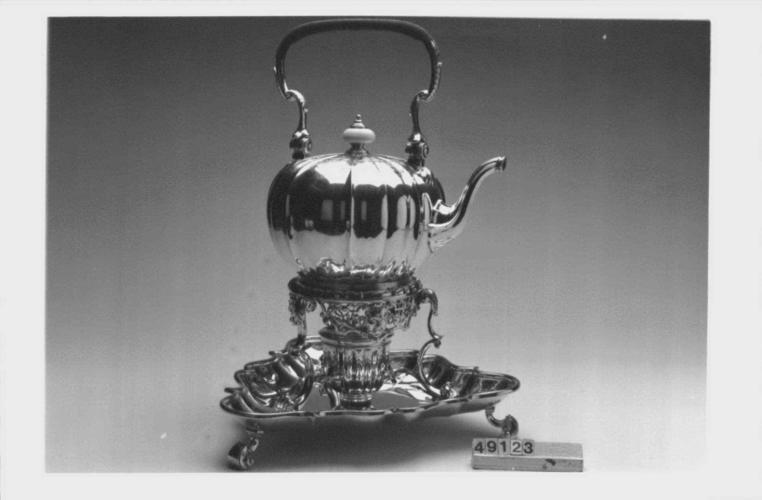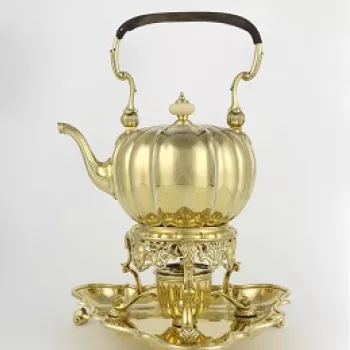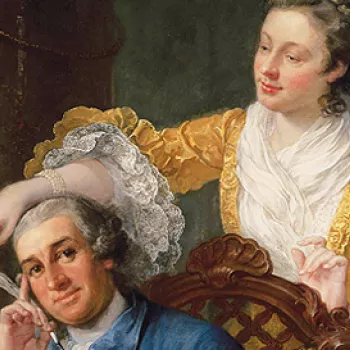Tea kettle hallmark 1732/3
Silver gilt | 39.0 x 27.2 x 27.2 cm (whole object) | RCIN 49123
-
A silver gilt melon-shaped tea kettle and stand, with a bail handle with leather grip, a hinged lid with ivory knop handle and a swan-neck spout; the body is engraved with stylised strapwork. The stand, fitted with a burner, has a pierced apron and three scroll legs with shell feet. On a triangular base with scroll feet.
Though hardly known on the continent, tea-drinking was highly fashionable in Britain in this period. In 1734 Thomas Twining (1675-1741) imported more than 13,000 lb of tea into Britain. All teas sold at this date were imported from China or Japan, and were highly taxed. Mary Delany frequently sent parcels of tea from London to her mother and sister, although she noted the rising costs of both green and black varieties. On 5 October 1727, for example, she wrote to her sister ‘Mrs Badge… has bought two pound of Bohea [black tea], at thirteen shilling a pound, which the man says is extraordinarily good; but everything of that kind grows very dear’. By May 1728 Bohea tea had risen to 20 shillings a pound, and green tea had risen from 12 to 30 shillings. Tea was thus a highly luxurious item and the tea service consequently of particularly high value by association. This is reflected in the genre scenes of the period which often show the tea service prominently displayed on the table. In Laroon’s Musical Tea Party (RCIN 403544) for example, tea is being served in porcelain tea-bowls, while the teapot is replenished with a silver kettle, its stand on the floor beside the table.
This tea service is first recorded in an inventory of 1832 as belonging to Frederick, Prince of Wales. It would have been an early purchase by the Prince, who did not spend lavishly on plate until the reconciliation with his father in 1741, and the grant of a greater allowance by Parliament. Until this point Frederick relied on plate existing in the Jewel Office for his evening parties. In August 1732, for example, the Plate Book records silver ‘delivered for an Entertainment His RH the Prince of Wales gives to Her Majesty at Kew on Monday next 21 Augt. 1732’. On Frederick’s marriage in 1736, George II gave him second-hand plate from the Jewel Office, which he then had replaced with new pieces for himself. Neither the gift nor the replacement included any tea-wares, which suggests that in this department at least, the Prince was already well provided.
The original service supplied to the Prince is listed in the 1832 inventory as containing a plated jug for serving hot milk or water, which no longer survives, and a further four caddies – two with flower finials and two beaded ones. This suggests that the Prince was able to offer his guests a huge variety of exotic teas. The flowered caddies may have been used to contain Pekoe tea, which was distinguished by the addition of dried white tea blossoms.
Text Adapted from The First Georgians; Art and Monarchy 1714 – 1760, London, 2014.Provenance
The tea-kettle, with accompanying tea-pot, coffee-pot, sugar basin and cream jug, forms part of the Prince of Wales' service, made for Frederick, Prince of Wales.
-
Creator(s)
(goldsmith)Acquirer(s)
-
Medium and techniques
Silver gilt
Measurements
39.0 x 27.2 x 27.2 cm (whole object)
Category












